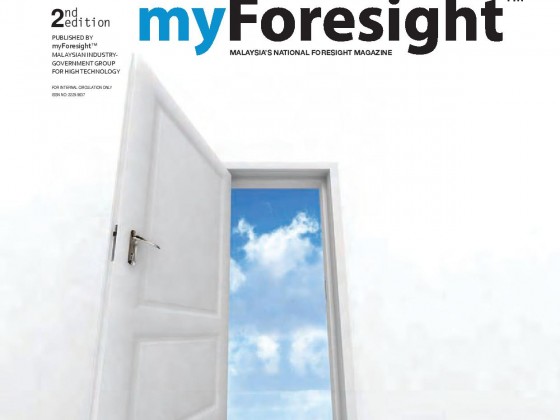The dilemma in trying to predict, understand as well as react to technological changes of the future, is that there is a need to understand the drivers of change which extend far beyond the domains of science and technology. In undertaking this effort, it is required to include a range of discipline involving the systematic study of science, social science and even the humanities as well as to draw upon the experience of those more directly engaged with the economy and society in industry, government and beyond.
by | Rushdi Abdul Rahim | rushdi@might.org.my
There is a need to create a systematic structure to enable contributors or participants to channel their knowledge and experience in a creative manner, not confined by short-term interests, biased opinions or prejudices. The process of designing and implementing these activities is called Foresight.
If you are reading this, you will be aware that a National Foresight initiative was conducted with the objective of identifying and prioritizing technology areas for Malaysia. Various engagement sessions were held to provide stakeholders.
It is worth to note that stakeholder’s engagement in some of the programmes was overwhelming that changes were required to be made on how the programme was to be conducted as well as requirement of larger venue for workshops and focus groups. This demonstrates there is interest in foresight activities as well as the willingness of participants to contribute and channel their knowledge and experience for the national wellbeing.
Therefore in this issue, we are unveiling the outcome of the foresight engagement; areas that were identified as important to Malaysia in the future; areas that the stakeholders feel significant towards creating a sustainable Malaysia in meeting the challenges and objectives of New Economic Model and Vision 2020.
Since the beginning of the year we have already presented this to certain quarters and already we’re receiving feedback. We welcome these. Since foresight is a continuous process, the feedback received will assist us in refining these areas. We are also glad to see there are already uptakes on the focus areas in the horizon.
During the course of presenting the findings, we were asked; How did we get to this conclusion? What methods were used?
Well the methods that were chosen signify the needs to cater its adoption to Malaysia’s case studies. Therefore the selection and combination of methods are made to ensure the best outcome and participation of stakeholders in Malaysia. This includes but not limited to the following:-
- The need to educate potential stakeholders on the benefits and potential impact of foresight;
- To negate the relatively high level of cynicism of the stakeholders;
- To enable change of thinking and mind set, thinking of the futures rather than today;
- To inculcate and incorporate discipline and subjectivity. This includes receptiveness towards methods and systematic approaches of foresight;
- To ensure engagement of diverse and equal distribution of participants;
- The need to sustain continued interest in the foresight exercises by introducing creative and participatory approaches;
- Enabling use of multi tools environment (social networking sites; online forum etc.)
Further insights on methods available on foresight and how it is chosen are covered by Rafael Popper’s ‘Critical Factors Influencing The Selection of Foresight Methods’. We believe this this will provide an interesting reading for those interested in conducting their own foresight.
You would also be able to see how foresight contributes significantly in a country S&T Planning. Hyun Yim’s article provides an insight how this was achieved in South Korea.
It is worth to note that further stakeholders engagement will be conducted for the rest of 2011. We will be embarking on a nationwide engagement with the youth. We firmly believe that we can’t really talk about the future without talking to those who will be there in the first place. We will also be conducting foresight workshops and focus groups in selected areas of interest and perhaps will be calling on you to participate. To date we have started to embark on initial work on both natural fibres as well as rail.
We know that after going through the magazine you will have formed your opinion on certain matters. We want to hear them. We welcome your feedback and contribution.
I am sure you will find the magazine beneficial and worth your time.









